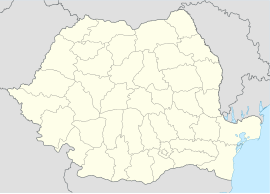Baraolt: Difference between revisions
→Natives: couple more |
→Demographics: add a ref, with inline citation |
||
| Line 33: | Line 33: | ||
==Demographics== |
==Demographics== |
||
At the [[2021 Romanian census|2021 census]], Baraolt had a population of 7,730. At the [[2011 Romanian census|2011 census]], the town had a population of 8,567, of which an absolute [[Székelys|Székely]] [[Hungarian people|Hungarian]] majority of 8,213 (96%) [[Hungarians]], as well as 237 (3%) [[Romanians]], 100 [[Romani people in Romania|Roma]], and 15 others;<ref>{{Cite web |url=http://www.covasna.insse.ro/phpfiles/DATE_PROVIZORII_RPL-2011_CV.pdf |title=Census data 2011 |access-date=2012-03-11 |archive-url=https://web.archive.org/web/20120417034859/http://www.covasna.insse.ro/phpfiles/DATE_PROVIZORII_RPL-2011_CV.pdf |archive-date=2012-04-17 |url-status=dead }}</ref> approximately 47.9% of the town's inhabitants adhere to the [[Reformed Church in Romania|Hungarian Reformed Church]], while 29.9% follow [[Roman Catholic Church|Roman Catholicism]], 16.8% consider themselves [[Unitarian Church of Transylvania|Unitarians]], and 2.6% are [[Romanian Orthodox]]. At the 2002 census, there were 9,670 inhabitants, of which 9,271 (95.87%) were Székely Hungarians, 300 (3.1%) Romanians, 84 Roma, and 15 others. |
At the [[2021 Romanian census|2021 census]], Baraolt had a population of 7,730.<ref name="RPL2021">{{cite web|url=https://www.recensamantromania.ro/wp-content/uploads/2023/05/Tabel-1.03_1.3.1-si-1.03.2.xls|title=Populația rezidentă după grupa de vârstă, pe județe și municipii, orașe, comune, la 1 decembrie 2021|publisher=[[National Institute of Statistics (Romania)|INSSE]]|language=ro|date=31 May 2023}}</ref> At the [[2011 Romanian census|2011 census]], the town had a population of 8,567, of which an absolute [[Székelys|Székely]] [[Hungarian people|Hungarian]] majority of 8,213 (96%) [[Hungarians]], as well as 237 (3%) [[Romanians]], 100 [[Romani people in Romania|Roma]], and 15 others;<ref>{{Cite web |url=http://www.covasna.insse.ro/phpfiles/DATE_PROVIZORII_RPL-2011_CV.pdf |title=Census data 2011 |access-date=2012-03-11 |archive-url=https://web.archive.org/web/20120417034859/http://www.covasna.insse.ro/phpfiles/DATE_PROVIZORII_RPL-2011_CV.pdf |archive-date=2012-04-17 |url-status=dead }}</ref> approximately 47.9% of the town's inhabitants adhere to the [[Reformed Church in Romania|Hungarian Reformed Church]], while 29.9% follow [[Roman Catholic Church|Roman Catholicism]], 16.8% consider themselves [[Unitarian Church of Transylvania|Unitarians]], and 2.6% are [[Romanian Orthodox]]. At the 2002 census, there were 9,670 inhabitants, of which 9,271 (95.87%) were Székely Hungarians, 300 (3.1%) Romanians, 84 Roma, and 15 others. |
||
The town has one high school and a provincial hospital with 82 beds. The hospital's specialties include internal medicine, surgery, obstetrics & gynecology, and paediatrics; it also has an accident and emergency service. |
The town has one high school and a provincial hospital with 82 beds. The hospital's specialties include internal medicine, surgery, obstetrics & gynecology, and paediatrics; it also has an accident and emergency service. |
||
Revision as of 11:36, 23 October 2023
Baraolt
Barót | |
|---|---|
 | |
 Location in Covasna County | |
| Coordinates: 46°4′30″N 25°36′0″E / 46.07500°N 25.60000°E | |
| Country | Romania |
| County | Covasna |
| Government | |
| • Mayor (2020–2024) | János Benedek[1] (Ind.) |
Area | 128.48 km2 (49.61 sq mi) |
| Elevation | 482 m (1,581 ft) |
| Population (2021-12-01)[2] | 7,730 |
| • Density | 60/km2 (160/sq mi) |
| Time zone | EET/EEST (UTC+2/+3) |
| Postal code | 525100 |
| Area code | (+40) 02 67 |
| Vehicle reg. | CV |
| Website | primariabaraolt |
Baraolt (Romanian pronunciation: [baraˈolt]; Template:Lang-hu, pronounced [ˈbɒroːt] ) is a town and administrative district in Covasna County, Romania. It lies in the Székely Land, an ethno-cultural region in eastern Transylvania. The town was mentioned for the first time as a settlement in 1224. It administers five villages: Biborțeni (Bibarcfalva), Bodoș (Bodos), Căpeni (Köpec), Micloșoara (Miklósvár), and Racoșul de Sus (Felsőrákos).
Geography
The town is located in the northwestern part of Covasna County, 44 km (27 mi) away from the county seat, Sfântu Gheorghe, on the border with Brașov County. It lies in the Baraolt depression, on the banks of the Baraolt River, surrounded by the Harghita Mountains to the north, the Baraolt Mountains to the east and the Perșani Mountains to the west. The nearest railway station is 6 km (3.7 mi) from it, in Augustin, Brașov.[3]
Demographics
At the 2021 census, Baraolt had a population of 7,730.[4] At the 2011 census, the town had a population of 8,567, of which an absolute Székely Hungarian majority of 8,213 (96%) Hungarians, as well as 237 (3%) Romanians, 100 Roma, and 15 others;[5] approximately 47.9% of the town's inhabitants adhere to the Hungarian Reformed Church, while 29.9% follow Roman Catholicism, 16.8% consider themselves Unitarians, and 2.6% are Romanian Orthodox. At the 2002 census, there were 9,670 inhabitants, of which 9,271 (95.87%) were Székely Hungarians, 300 (3.1%) Romanians, 84 Roma, and 15 others.
The town has one high school and a provincial hospital with 82 beds. The hospital's specialties include internal medicine, surgery, obstetrics & gynecology, and paediatrics; it also has an accident and emergency service.
Demographic movement according to the censuses:

Natives
- Dávid Baróti Szabó (1739–1819), Hungarian Jesuit priest, poet, writer, and linguist
- Mihály Bodosi (1909–2005), Hungarian athlete
- Eduard Derzsei (1934–2015), Romanian volleyball player
- Líviusz Gyulai (1937–2021), Hungarian graphic artist, printmaker, and illustrator
References
- ^ "Results of the 2020 local elections". Central Electoral Bureau. Retrieved 10 June 2021.
- ^ "Populaţia rezidentă după grupa de vârstă, pe județe și municipii, orașe, comune, la 1 decembrie 2021" (XLS). National Institute of Statistics.
- ^ "Bun venit, pe site-ul oficial al orașului Baraolt!". primariabaraolt.ro (in Romanian). Baraolt town hall. Retrieved October 16, 2023.
- ^ "Populația rezidentă după grupa de vârstă, pe județe și municipii, orașe, comune, la 1 decembrie 2021" (in Romanian). INSSE. 31 May 2023.
- ^ "Census data 2011" (PDF). Archived from the original (PDF) on 2012-04-17. Retrieved 2012-03-11.
External links
- (in Romanian) About the town on Covasna County's Prefecture's Site Archived 2012-03-30 at the Wayback Machine
- (in Hungarian) About the town on Covasna County's Council's site



